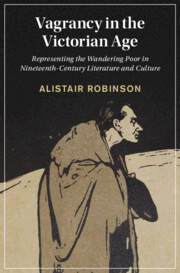 Vagrancy in the Victorian Age
Vagrancy in the Victorian Age from Part III - The Frontier
Published online by Cambridge University Press: 02 November 2021
Vagrants abound in the writings of British travellers who visited antebellum America. This chapter focuses on the representation of three of these vagrant figures. First, the pauper immigrant, a figure whose mobility was vigorously contested by British and American commentators. For the British these immigrants belong to the deserving poor – their rootlessness was temporary and incidental; for the Americans they were often perceived as undeserving vagrants and a potential financial burden. Second, the American Indian, a figure who was frequently compared to the English Gypsy, and whose nomadism was often repositioned as vagrancy and a sign of their impending extinction. And third, the American vagabond, a vagrant and anarchic figure who was represented as a lawless reprobate living on the frontiers. These three figures were interpreted using a range of representational strategies that were current in Britain, and together they demonstrate the flexibility of vagrant discourses – their ability to circulate globally as well as locally. Among other writers, this chapter examines the works of Frances Trollope, Harriet Martineau and Charles Dickens.
To save this book to your Kindle, first ensure no-reply@cambridge.org is added to your Approved Personal Document E-mail List under your Personal Document Settings on the Manage Your Content and Devices page of your Amazon account. Then enter the ‘name’ part of your Kindle email address below. Find out more about saving to your Kindle.
Note you can select to save to either the @free.kindle.com or @kindle.com variations. ‘@free.kindle.com’ emails are free but can only be saved to your device when it is connected to wi-fi. ‘@kindle.com’ emails can be delivered even when you are not connected to wi-fi, but note that service fees apply.
Find out more about the Kindle Personal Document Service.
To save content items to your account, please confirm that you agree to abide by our usage policies. If this is the first time you use this feature, you will be asked to authorise Cambridge Core to connect with your account. Find out more about saving content to Dropbox.
To save content items to your account, please confirm that you agree to abide by our usage policies. If this is the first time you use this feature, you will be asked to authorise Cambridge Core to connect with your account. Find out more about saving content to Google Drive.